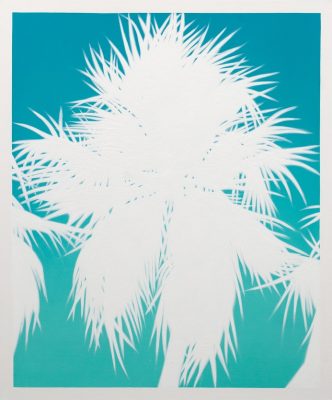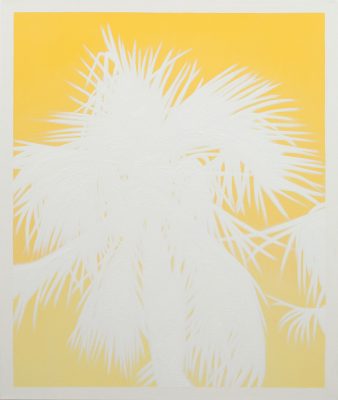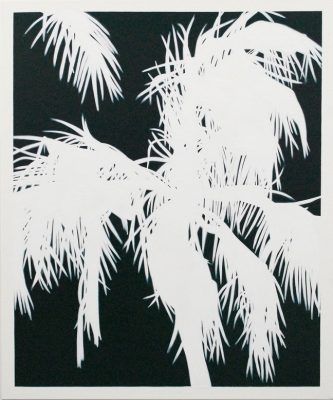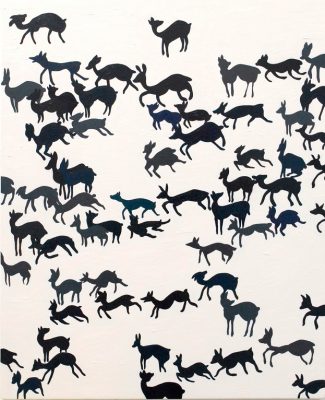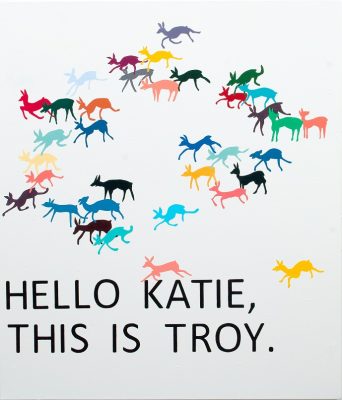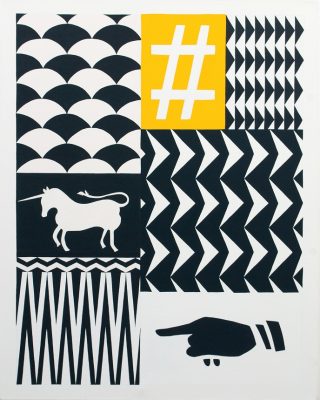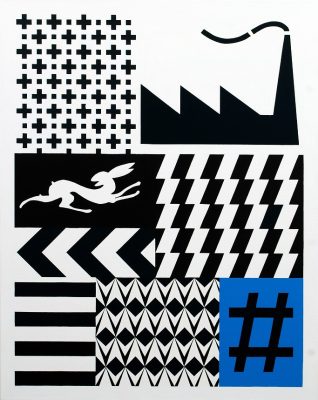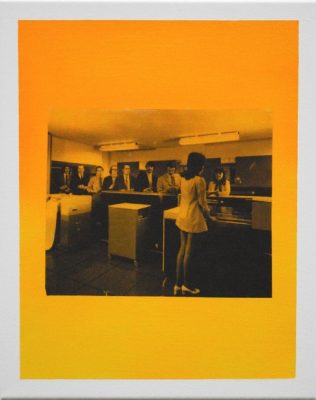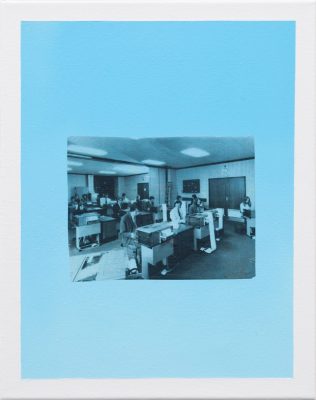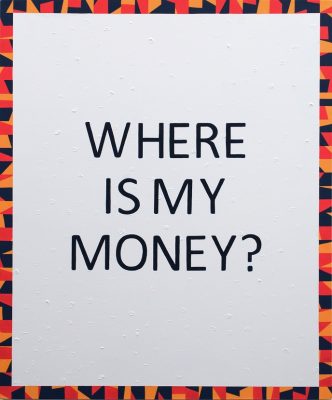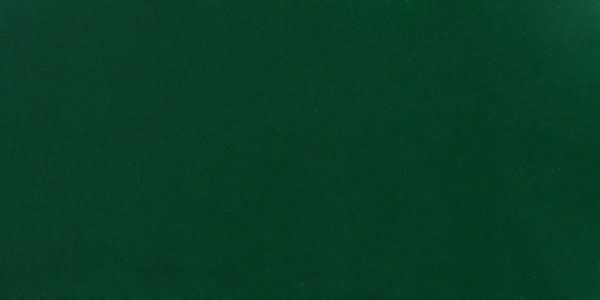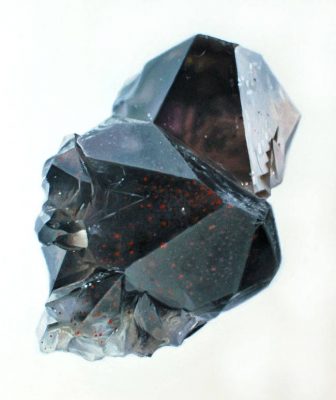White silhouettes sway against softly gradated backgrounds: blues, purples, yellows and pinks. The painted palm trees are tacky and kitsch. They invoke long stretches of beach and crystalline waters, images seen many times before, perhaps not in life, but in that common currency of signs endlessly circulated and reproduced in advertisements and mass-culture. During a studio visit earlier this year, Rob Sherwood explained that the series of works was inspired by a poster of an idyllic beach stuck onto the wall of a gloomy, windowless office. He described it as an ‘image of an image’, because the poster drew upon the icons and symbols of the collective imaginary, offering the viewer a representation of nature that it is both culturally and economically encoded. The same might be said of the five painted palm trees, which are currently on display alongside other paintings in the front window of the Hannah Barry Gallery in London. Dreams of adventure or escape, the Hollywood of myth, tall shadows criss-crossing the Sunset Strip—what becomes apparent when looking at these works is that their familiarity cannot be accounted for adequately by recourse to what they represent. If they are immediately recognisable, it is not simply because they are paintings of palm trees as objects, so much as paintings of palm trees as ideas.
To paint the idea of something, the image of an image, suggests that the idea resides in some imagistic realm more pure than the objective world because less material. And it is true that there is a certain breeziness to these paintings that makes them look idealised and almost decorative. This criticism is often levelled at still-life painting, more forcefully termed nature morte, the lowest of the traditional genres and the most readily assimilated into the private sphere of the home as an ornamental commodity. Yet in each of the paintings in question—suggestively titled ‘Shaman Faced’, ‘Desktop Riviera’, ‘Eager Leaves’, ‘Nothingwise’ and ‘How To Get A Fire Going’—there is a sense in which the image and the dreams it induces disintegrate from within. To spend time with the works is to see how the fronds of each palm tree gradually liquefy; how each image is cut and cropped by the frame of the canvas; how the central portion of each work, made up of several layers of thick, coagulated paint, begins to collapse into a formless glut of light. Paradoxically, white functions here as a distorting element that not only reflects and illuminates but, in the manner of an overexposed photograph, renders opaque. It is as though something as immaterial and as pure as light were being debased, made sticky and abject. On this view, it is telling that the artist describes each painting as a ‘person with sprawling limbs’, as though a palm tree might morph into a body collapsing under its own dead weight. The reference to the human anatomy may seem counterintuitive (though it is not without precedent—Kazimir Malevich, the founder of Suprematism, described his geometric abstractions as ‘living bodies’). Yet it does help to account for the fetishistic and intensely haptic quality of these paintings, their appeal to the spectator’s sense of touch as well as vision, and, provided we do not look already knowing what we are going to see, their psychic charge.
What, then, might motivate this tendency towards debasement, the almost uncanny sense that each image is disintegrating from within? In another painting displayed in the exhibition, ‘The Junkman’s Lament’, a question is posed in bold capital letters that may provide a way of thinking about this problem: ‘WHERE IS MY MONEY?’ The letters are painted black against a white background that shows traces of the grid with which Sherwood has previously worked. The painting is framed by an intricate pattern of geometric shapes painted red, blue and yellow, a quotation perhaps of a large folding screen the artist produced for an exhibition at London’s Son Gallery in 2012. The question posed by ‘The Junkman’s Lament’ can be interpreted in several ways. It might be read as the complaint of a penurious artist to his gallerist. Or it might be the question asked by a consumer rudely awakened to the fact that the dream he has procured is a counterfeit. The work’s title also brings to mind a historical figure that the writer and cultural theorist Walter Benjamin calls the ‘rag picker’. The rag picker collects urban refuse, ‘everything that the big city has thrown away, everything it has lost, everything it has scorned, everything it has crushed underfoot’. For Benjamin, the rag picker is comparable to the artist, whose task it is to collect the traces left behind by the destructive cycles of modernisation and to transmute them into aesthetic objects. The poet Charles Baudelaire was in this respect exemplary, since he understood better than most the ‘profound duplicity’ of artistic production in capitalist modernity. As Benjamin writes, ‘Baudelaire knew the true situation of the artist; he goes to the marketplace as a flâneur, supposedly to take a look at it, but in reality to find a buyer’. Like the rag picker, the artist gathers together what has been abjected by history and weaves it into an object of aesthetic value that is exchanged on the market for money. To understand the question posed in ‘The Junkman’s Lament’ from this perspective is suggestive, not least because the various elements in the painting are inseparable from the failed utopian projects of the historical avant-gardes—geometric abstraction, the grid, the monochrome—elements that could be described as the remains of artistic modernism. In the present context, the possible relationship between the junkman and the rag picker may help to account for Sherwood’s working methods and for what I take to be the duplicitous character of his work. As with the paintings of kitsch palm trees, where, in an unsettling reversal, an object of desire morphs into an image of death, the other works displayed in the exhibition seem to dramatise their status as desirable commodities in the very same act in which they call that status into question.
In a pair of works titled ‘New Earth Tapestry #1’ and ‘New Earth Tapestry #2’, for example, various abstract shapes, symbols and icons have been combined in paintings reminiscent of hieroglyphs or medieval heraldry. In the first work, the spectator encounters a series of graphic designs, a unicorn, a pointing finger and a hash tag, the only symbol in the work to be painted against a yellow background. In the second work are similar abstract designs, as well as a factory, a hare and a hash tag, this time painted against a blue background. During the same studio visit, the artist explained that the unicorn and the hare were simplified versions of figures found on antique tapestries and ceramics in the Victoria and Albert Museum in London. The image of the factory was found in an open source dictionary of symbols, while the pointing finger was based on an image stencilled on a wall inside an old industrial building in Southwark where Sherwood rented a studio, a building recently demolished to make way for apartments. Meanwhile the hash tag, which, the artist observed, is also a small grid, was employed because in the language of computation it serves as a tool for stringing information together, often indiscriminately. For this reason the two paintings could also be expressed as ‘#harefactory’ or ‘#unicornfinger’, as the artist puts it.
As with the palm tree paintings, the use of recognisable icons and motifs in these works does not lead to clarity but to a certain illegibility. ‘New Earth Tapestry #1’ and ‘New Earth Tapestry #2’ invite the spectator to interpret the various pictorial elements and to find meaning in the constellations produced by their interplay. Taken together, however, they are indecipherable, like picture-puzzles whose solutions have been lost or ‘road signs to random information’, as Sherwood describes them. In this respect, the works seem to operate in a manner comparable to Sigmund Freud’s notion of the dream-work. According to Freud, the dream-image attains its imaginary unity through processes of condensation and displacement. These processes allow for disparate elements in a dream sequence—’a house with a boat on its roof, a single letter of the alphabet, the figure of a running man whose head has been conjured away’—to be woven into a composite image. Yet the dream-image is not reducible to its constituent parts, which, like puzzle-pieces, mean nothing in isolation, and is always on the brink of unravelling. For Freud, this explains why the telling of a dream is often beleaguered by a sense that something has been missed or lost. Likewise, in ‘New Earth Tapestry #1’ and ‘New Earth Tapestry #2’, the hash tags set in motion a string of information knotted together into a material composite, a ‘tangle of dream thoughts’, to use Freud’s terms, in which meaning is intimated only to be withheld. As with the dream-work, moreover, the paintings are not static combinations of images but operational. The world interior of each work generates and is traversed by flows of illegible signs and meaningless information. However self-referential and abstruse the paintings seem, in this respect the fabric of the works, its warp and its weft, is woven out of the same stuff as the capitalist dream world of which they form a part.
It was perhaps Benjamin who first put forward a relationship between the dream-work and the commodity fetish. In his writings on the Parisian arcades, for instance, he describes in vivid terms the dream-like or phantasmagorical quality of commodities and the way in which inanimate objects seem to be inhabited by a ‘soul’. Benjamin noted how commodities assumed a doubled life as use-values and as values exchangeable for a particular sum of money. The exchange-value of a commodity conceals its social character and presents itself as intrinsic to the commodity itself, thereby endowing the object with a quasi-theological aura. This explains why Benjamin cites Marx’s observation that ‘value (…) converts every product into a social hieroglyphic’. Like an enigmatic dream-image, the commodity fetish seems to intimate something more than the sum of its parts. It is this duplicitous character that is arguably foregrounded in Sherwood’s works. On this view the question posed in the ‘Junkman’s Lament’—’WHERE IS MY MONEY?’—is perhaps best taken literally. It is as though each work were really asking, ‘Where is the real of my value?’
When talking about the palm tree paintings, Sherwood described how he had happened upon a passage in a book which claimed that the Ancient Assyrians worshiped the palm tree because it served as a ladder connecting earth to heaven. He wondered whether the palm tree was still worshiped today. To look at the paintings in question, there is a sense in which each image is endowed with a dream-like aura. After all, these are not paintings of palm trees as objects so much as paintings of palm tree as ideas, ‘images of images’ whose object has been lost. Perhaps this loss can be understood as symptomatic of a world encoded by money, where our desire for and devotion to things has less to do with the things themselves than the ideas they embody, which never quite add up. For the palm trees fail to materialise the dream of value. They are not images of plenitude but images in a state of collapse. In this they reveal the drives that set our dreams in motion. It is this unresolved dialectic that is enacted in different ways in each of the paintings in the exhibition, a window filled with disintegrating palm trees and tapestries of dreams, signposts on the road to ruin.
Rob Sherwood’s ‘The Mercury Room’ is on view at Hannah Barry Gallery to 27 February 2015.
